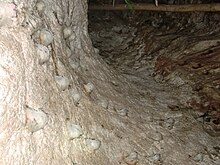The most heavily harvested nests are from the edible-nest swiftlet or white-nest swiftlet (Aerodramus fuciphagus) and the black-nest swiftlet (Aerodramus maximus).[5] The white nests and the red nests are supposedly rich in nutrients, which are traditionally believed to provide health benefits.[2]
Most nests are built during the breeding season by the male swiftlet over a period of 35 days. They take the shape of a shallow cup stuck to the cave wall. The nests are composed of interwoven strands ofsalivary cement. Both nests have high levels of calcium, iron, potassium, and magnesium.[3]
Hong Kong and the United States are the largest importers of these nests.[6] In Hong Kong, a bowl of bird's nest soup would cost US$30 to US$100.[2][6] A kilogram of white nest can cost up to US$2,000, and a kilogram of red nests can cost up to US$10,000. The white nests are commonly treated with a red pigment, but methods have been developed to determine an adulterated nest. Natural red cave nests are often only found in limestone caves in a bird nest concession island in Thailand.[3]The high cost and demand has attracted counterfeiters, leading to the halt of Malaysian nest exports to China; the Malaysian government has undertaken to employ RFID technology to thwart counterfeiting by micro-chipping nests with details about harvesting, packaging and transport.[7] Industrial quality-control techniques such as failure mode and effects analysis have been applied to edible bird's nest processing at nesting houses in Sarawak, Malaysia and reported by a research team in by Universiti Malaysia Sarawak.[8][9][10]
The nests were formerly harvested from caves, principally the enormous limestone caves at Gomantongand Niah in Borneo. With the escalation in demand these sources have been supplanted since the late 1990s by purpose-built nesting houses, usually reinforced concrete structures following the design of the Southeast Asian shop-house ("rumah toko"/"ruko").[11] These nesting houses are normally found in urban areas near the sea, since the birds have a propensity to flock in such places. This has become an extraordinary industry, mainly based on a series of towns in the Indonesian Province of North Sumatra, which have been completely transformed by the activity. From there the nests are mostly exported to the markets in Hong Kong, which has become the centre of the world trade, though most of the final consumers are from mainland China. It has been estimated[citation needed] that the products now account for 0.5% of the Indonesian GDP, equivalent to about a quarter of the country's fishing industry. The entire global industry is an estimated $5 billion.

Hiç yorum yok:
Yorum Gönder